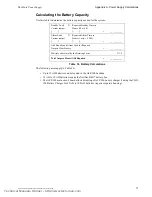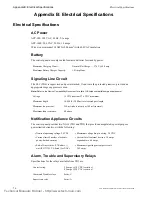
4. Operation
Alarm Operation
64
AFP-100/AFP-100E Instruction PN 51010:C1 02/06/2002
Alarm Operation
Alarm operation is similar to trouble operation, but with the following differences:
• The panel sounder produces a steady output, not pulsed.
• The System Alarm (not Trouble) LED flashes.
• ALARM: device name, type and address are displayed.
• Alarms latch and
are not allowed to clear automatically.
• Alarms activate software zones (control-by-event logic) if so programmed.
• Timers (Silence Inhibit, Auto-silence, Trouble Reminder) are started.
• Alarms activate the general alarm relay and zone Z00 (NAC 01 and NAC 02).
• The trouble relay is not activated.
A typical alarm display would be:
Supervisory Operation
Supervisory operation is similar to alarm operation but with the following differences:
• The panel sounder is a warbling sound.
• The Supervisory LED (not Alarm) flashes.
• The Display Status label is Active.
• Supervisory relay is activated.
• Silenced alarms are not resounded.
• Timers are not started.
• The alarm relay is not activated.
A typical supervisory event would display:
Note that, like alarms, supervisory signals latch and can be assigned to a software zone. Supervisory
alarms do not cause resound as do other alarm conditions. Open circuits in supervisory wiring are
processed by the control panel the same way as other trouble conditions.
NAC (Notification Appliance Circuit) Operation
The control panel has two NACs: NAC 01 and NAC 02.
NAC 01 and NAC 02 are programmable. Both NACs may be either silenceable or nonsilenceable and
may be programmed as steady or coded operations. Coded operation includes March Time, Temporal or
California types. Refer to "Coded Operation - NAC 01 and NAC 02" on page 66, for additional
information on coding.
ALARM: PULL STAT M02
<ADJ><NOUN> ZONE #
ACTIVE TAMPER M02
<ADJ><NOUN> ZONE #
Technical Manuals Online! - http://www.tech-man.com





































